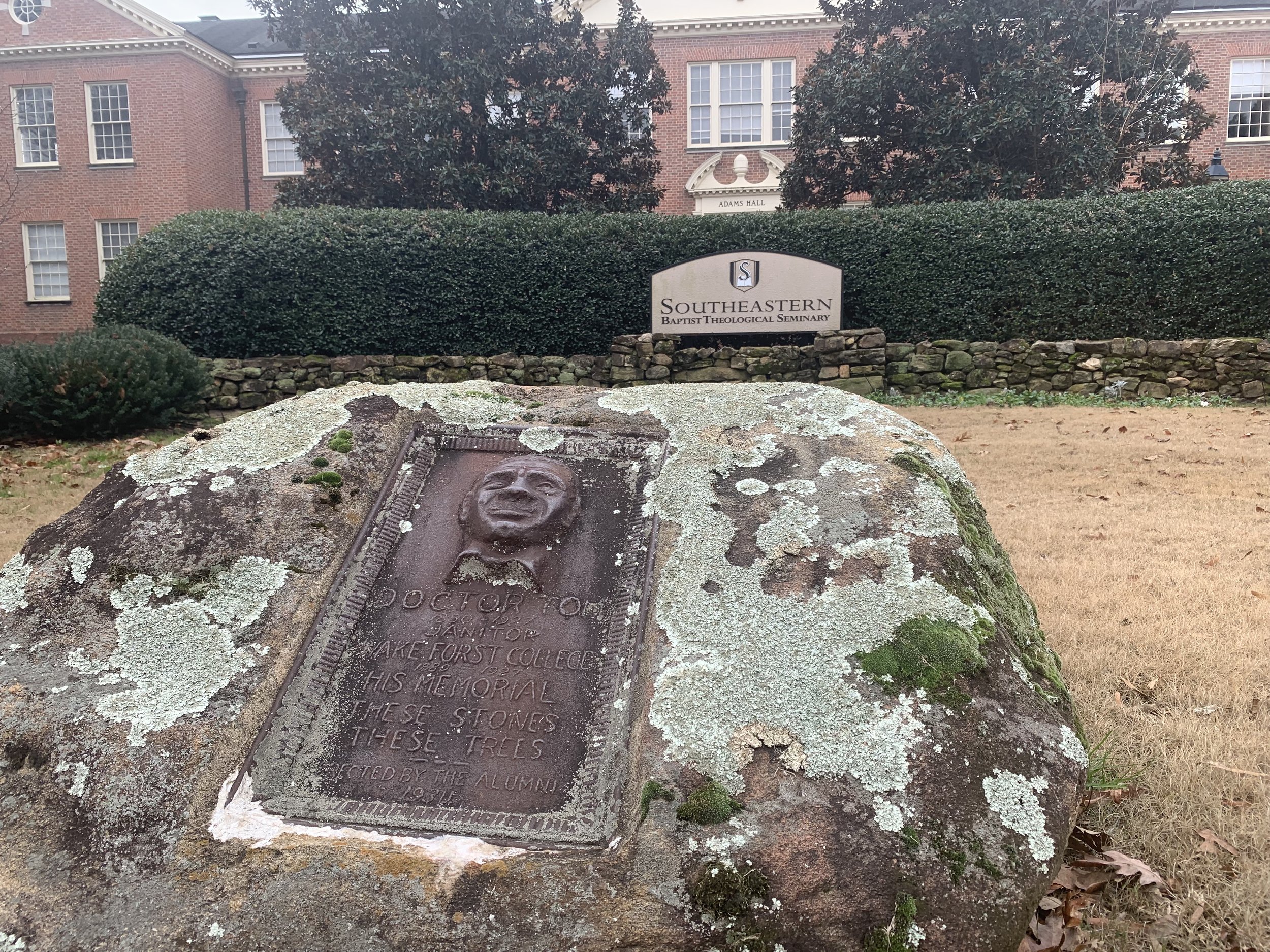In the educational, spiritual and aesthetic center of town stands a collection of beautiful buildings spread across 300 acres of meticulously maintained grounds. Starting in 1834 and ending in 1956 when it relocated to Winston-Salem, it was once home to Wake Forest College. In 1951, Southeastern Baptist Theological Seminary began offering classes there, and acquired the entire campus in 1956.
The landscape of the abundant acreage evolved over the first 100 some years -- most notably to include the creation of a sturdy and charming fieldstone wall that surrounds the campus -- built from 1885 to the early 1900s. Made without mortar, the walls are flexible and withstand changing environmental conditions like rain, temperature and shifting ground.
Along with five gates on the north, west and south sides, the lush lawns, mature trees and shrubs that adorn the grounds, the sense of beauty, peace and purpose emanating from this sacred space cannot be overstated. The gates are formed by stone bases, extensions of the walls, and support delicate cast-iron arches. Electric lamps set in the peaks of the arches were installed in the early 1990s.
Indeed, for those lucky enough to live or work nearby, or make it part of a Downtown visit, to walk across the grounds is both like being transported back in time and to experience what amounts to an ambulatory meditation. To follow the paths as they crisscross the campus, in close proximity to the large and leafy magnolia and boxwood trees and abundant azaleas, pansies and tulips, to admire the simple bricked beauty of the buildings and landscape architecture, all surrounded and insulated by the stone wall, wondering how it came together and imagining all who were there before, constitutes something of a spiritual experience in itself.
Two bronze plaques are located near the wall on the south and north sides of campus. The north plaque commemorates Doctor Tom (Tom Jeffreys), a beloved maintenance man and gardener at Wake Forest College from 1880 to 1927, who constructed the stone walls, along with Len Crenshaw.
"Dry-laid stone walls are found throughout the historic areas of Wake Forest and contribute to the character and sense of place of the Town," said Michelle Michael, Senior Planner for Historic Preservation. "These walls were erected using local materials to build retaining walls, boundaries and property lines. They are a significant part of our historic landscape and are worthy of preservation."
Jeffreys was born enslaved on a plantation in Virginia around 1846. After working as a tenant farmer, he moved to Wake Forest with his wife, Virginia, and children around 1880. Soon after he was hired as a janitor at Wake Forest College and worked there until his death in 1927.
Len Crenshaw and his parents, Allen and Lender, were enslaved by William Crenshaw, an early trustee of Wake Forest College. In the 1830s, Crenshaw hired-out Len’s parents to work on campus, which may have influenced Len’s decision to seek employment at the school as an adult.
The south plaque commemorates Douglas Buttram, a Seminary student who repaired the walls in the early 1990s.
"We couldn't be more grateful to these men who created and maintained this structure that will long endure and contribute to the aesthetic and overall quality of life in Wake Forest," said Jason Cannon, President of the Wake Forest Business & Industry Partnership (WFBIP). "It is a site to behold from all directions that we sincerely hope will stand for all time."
For her part, North Main Street resident and longtime Wake Forest Garden Club member Ruth Ann Dyer said, "The wall is a symbol of what we once were and how we started, and greatly contributes to the small-town character of the town." Happy to see other neighborhoods such as Heritage and Traditions building similar walls, albeit with different stones, Dyer said there's a charm in the simplicity that the Seminary and the wall symbolize.
"I can't imagine the center of our town not having that wall," Dyer said. "It's not to keep people out or in, but an invitation to walk on top of or sit on and breath the freshness of our town."
"There's a sense of peace there," Dyer said of the Seminary. "Walk the brick walkway, sit for a spell on the benches or on the wall. Take in the beauty of the scenery. Look at the trees and smell the fragrance of the flowers drifting through the air. It is the core of this community. It always has been and always will be."
According to Ed Morris, the retired director of the Wake Forest Historical Museum & Wake Forest College Birthplace, when anyone comes into downtown Wake Forest they can't help but notice the obviously old stone wall. "Visitors and residents alike must wonder why it is there and when was it constructed," he said. "Few likely know that it was built by a former enslaved man in the late 1800s."
The learned historian went on to say that stone walls were not a part of a typical North Carolina landscape, and therefore far more noticeable than a wooden or iron fence might be.
"Jefferies convinced Wake Forest College president Charles Taylor that the wall would be a maintenance-free alternative to the wooden fence that surrounded the college campus for most of the first 75 years of its existence," Morris said.
The fence and the wall both had a purpose, he continued: to identify the campus from the surrounding community; but also to keep neighboring livestock from wandering into the grounds and damaging the landscape, and to contain the sheep that were used to keep the grass mowed on the college campus.
Over time, the wall became a landmark of both the college and town, Morris said. It also became a monument to Tom Jefferies, as stated on the plaque to his memory erected in 1931, four years after his death. Jefferies served the college as gardener, maintenance man, janitor and philosopher for nearly half a century.
"Today, the Wake Forest community has embraced the stone wall as a symbol of the historical town," Morris said. "In new development, from the Heritage area and others to Joyner Park. And even traffic circles."









